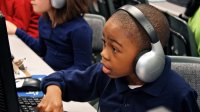Technology Integration Research Review
Your content has been saved!
Go to My Saved Content.Editor's Note: This article was originally written by Vanessa Vega, with subsequent updates made by the Edutopia staff.
Technology integration can be one of the most challenging topics to find quality research on. The term itself is a broad umbrella for numerous practices that may have little in common with each other. In addition, technology tools change rapidly, and outcomes can vary depending on implementation. Edutopia's tech integration review explores some of the vast body of research out there and helps you navigate useful results. In this series of four articles, learn about three key elements of successful technology integration, discover some of the possible learning outcomes, find tips for avoiding pitfalls when adopting new technologies, and dig into a comprehensive annotated bibliography with links to all the studies and reports cited in these pages.
What Is Successful Technology Integration?
A key transition over the history of information technology has been in the shift from passive audiences to active users. Digital technologies permit users unprecedented control over the content they consume and the place in and pace at which they consume it. At the heart of effective technology integration practices, digital technologies offer learners greater opportunities to be more actively involved in the learning experience.
Read our article about successful technology integration for more ideas on the many different ways teachers and schools are integrating technology today.
Learning Outcomes
According to findings culled from five meta-analyses, blending technology with face-to-face teacher time generally produces better outcomes than face-to-face or online learning alone (Cheung and Slavin, 2011; Cheung and Slavin, 2012; Tamim, Bernard, Borokhovski, Abrami, and Schmid, 2011; Means et al, 2009; Means et al., 2013). An analysis of effective technology use for at-risk students found that simply replacing teachers with computer-based instruction typically yields no learning benefits. Rather, blending technology with teachers to support interactive learning, exploration, and creation (instead of “drill and kill” techniques) leads to higher engagement and learning gains (Darling-Hammond, Zielezinski, & Goldman, 2014). However, there is currently limited rigorous research on the specific features of technology integration that improve learning. Meanwhile, the marketplace of learning technologies continues to grow and vary widely in terms of content, quality, implementation, and context of use.
One theme that has emerged from the research to date is that simply adding technology to K-12 environments does not necessarily improve learning. Rather, what matters most is how students and teachers use technology to develop knowledge and skills. Successful technology integration for learning generally goes hand in hand with changes in teacher training, curricula, and assessment practices (Zucker and Light, 2009; Bebell and O'Dwyer, 2010; Innovative Teaching and Learning Research, 2011). Edutopia's review of the literature also finds that successful technology integration generally involves three key principles:
In the next section, we will look at research on technology integration practices that improve K-12 learning and will highlight specific tools.
